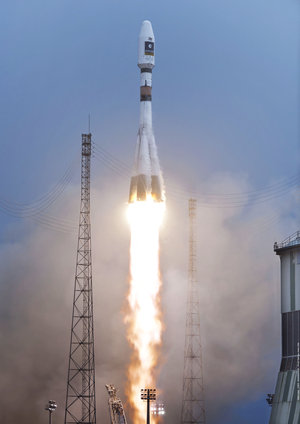Soyuz – from Baïkonur to French Guiana
Last February, on the occasion of the launch of ESA's Rosetta comet-chaser, European and Russian space officials waded into the dense undergrowth to visit the site of the future launch complex to be used by the Soyuz rocket.
Until recently covered in humid jungle vegetation, the area is in the locality of Sinnamary, situated along the coast, a few kilometres to the northwest of the present Ariane-5 launch pad in Kourou, French Guiana. Preliminary work has now started and the objective is to have the first launch of the Russian rocket from French Guiana in 2007.
Under its original name Semiorka, the vehicle was conceived in the 1950s as an intercontinental ballistic missile. Since 1957 it has flown more than 1600 times in different versions, orbiting spacecraft and regularly putting humans into space, as on ESA's recent Delta mission. Today it is considered to be one of the most reliable launchers in the world. Since 1996, it has also been commercialised by the European/Russian organisation Starsem.
The idea of flying Soyuz out of French Guiana, in addition to its historic site of Baïkonur, has been nurtured since 2001 and was formally approved in November last year by an inter-governmental agreement signed in Moscow.
The 300 million euro project, under the aegis of the European Space Agency, aims to offer a complete range of launch services from the Europe’s Spaceport. The medium-sized Soyuz launcher will take its place between Ariane-5 with its 6-10 tonne lift-capacity into geostationary orbit, and the smaller-sized Vega rocket, under development by ESA, that will be able to place 1.5 tonnes into a 700-km altitude orbit.
Launching the Russian vehicle from the equatorial site, where the Earth's rotation gives an additional boost, will improve performance and greatly increase the Russian rocket's attractiveness. Lifting off from Europe’s Spaceport will enable Soyuz to launch up to 3 tonnes into geostationary orbit.
Arianespace will be operating the Soyuz from French Guiana and has just announced its first related contract. Australia's Optus telecommunications company has bought two satellite launches, one on Ariane-5 at the end of 2005, and another on the "Guyanese" Soyuz inaugural flight in 2007.
The new career of Soyuz may well see more than just launching commercial telecommunications craft or science satellites. It opens another exciting avenue, that of possibly carrying out human spaceflights from French Guiana.





